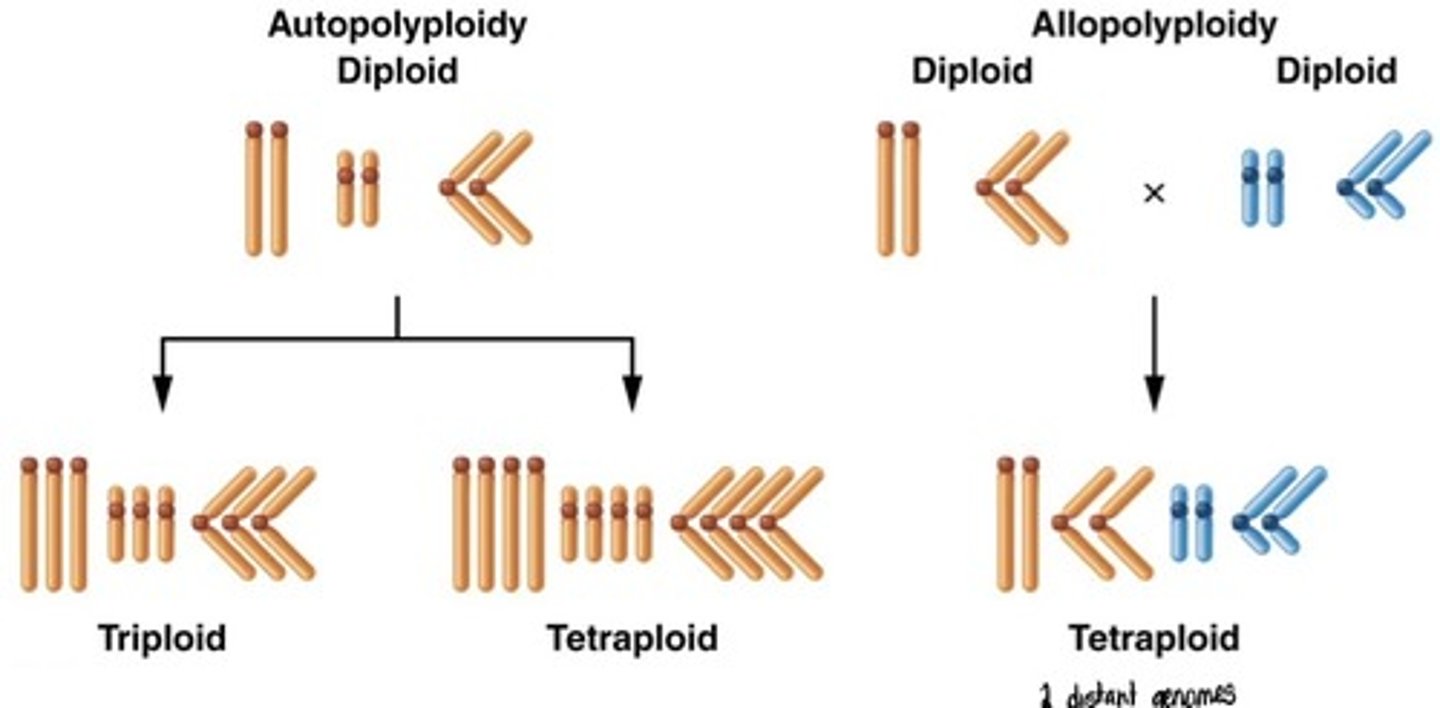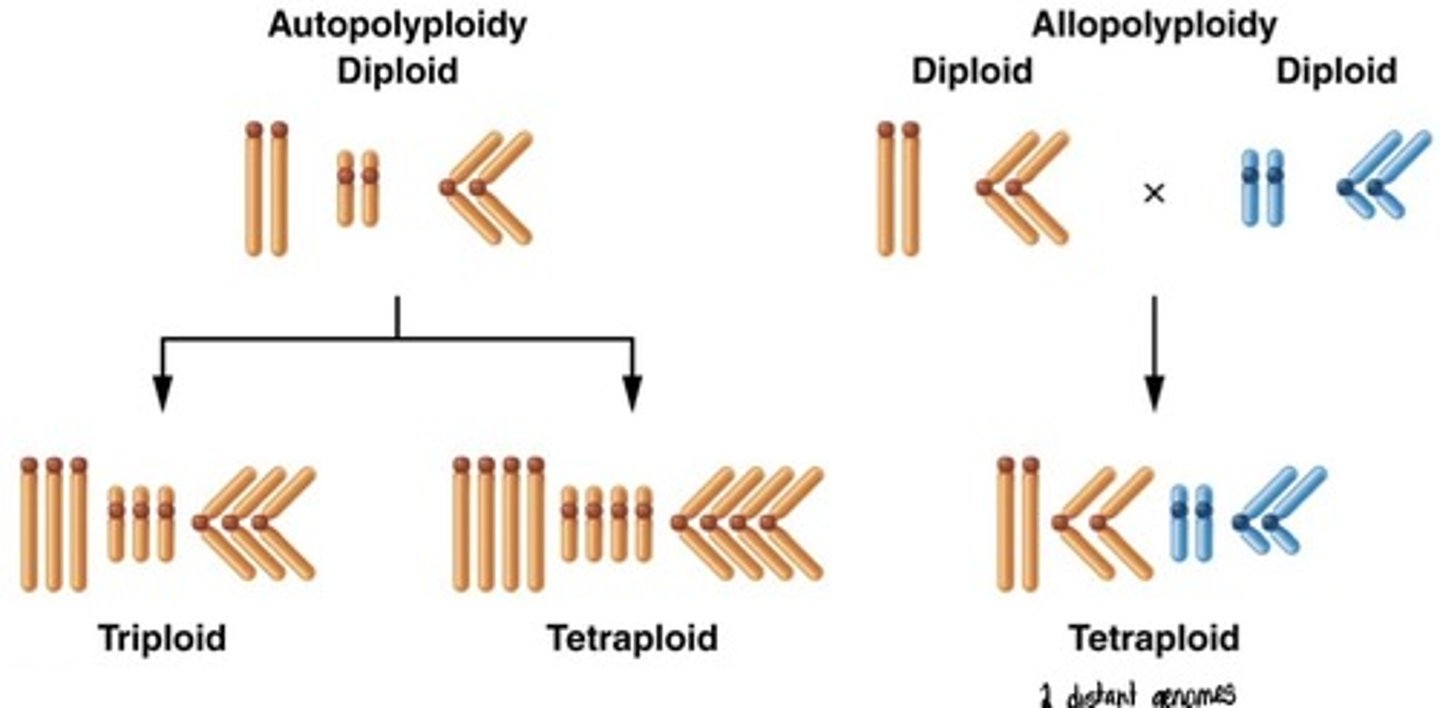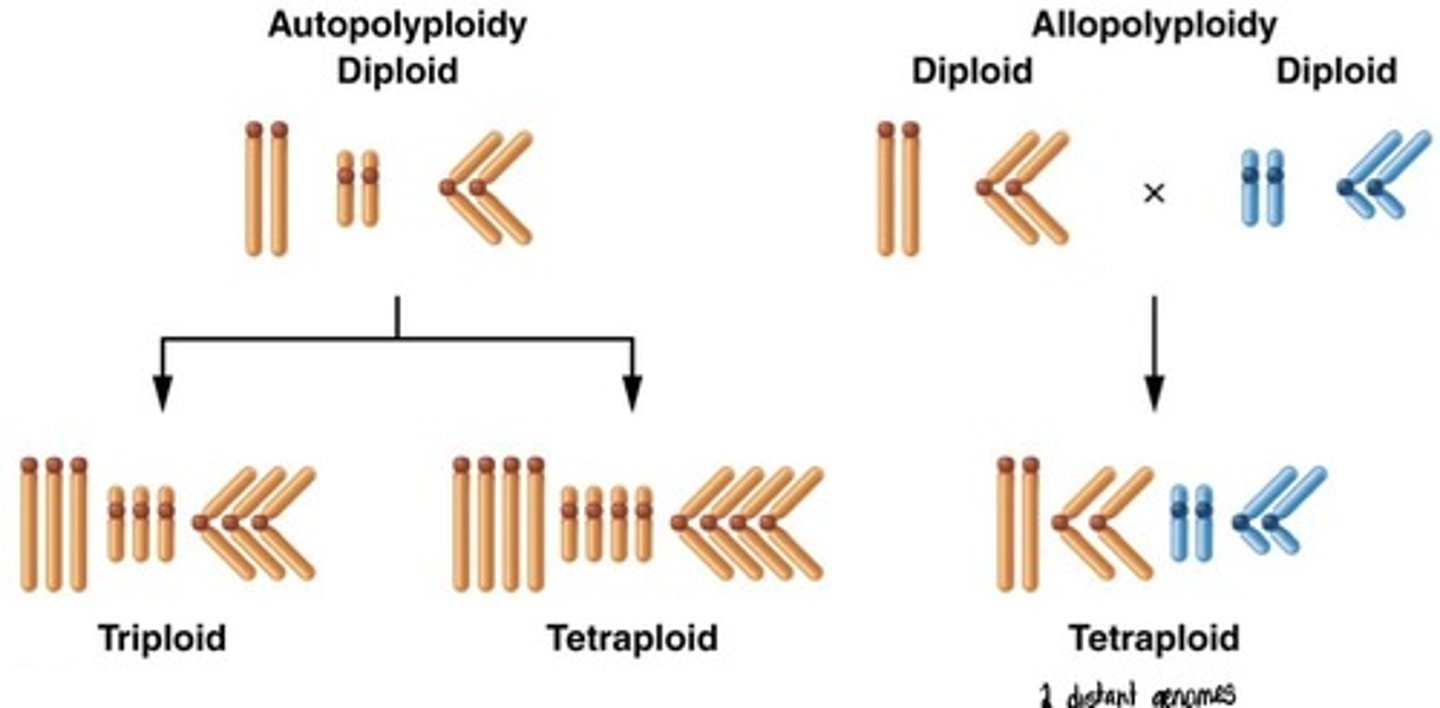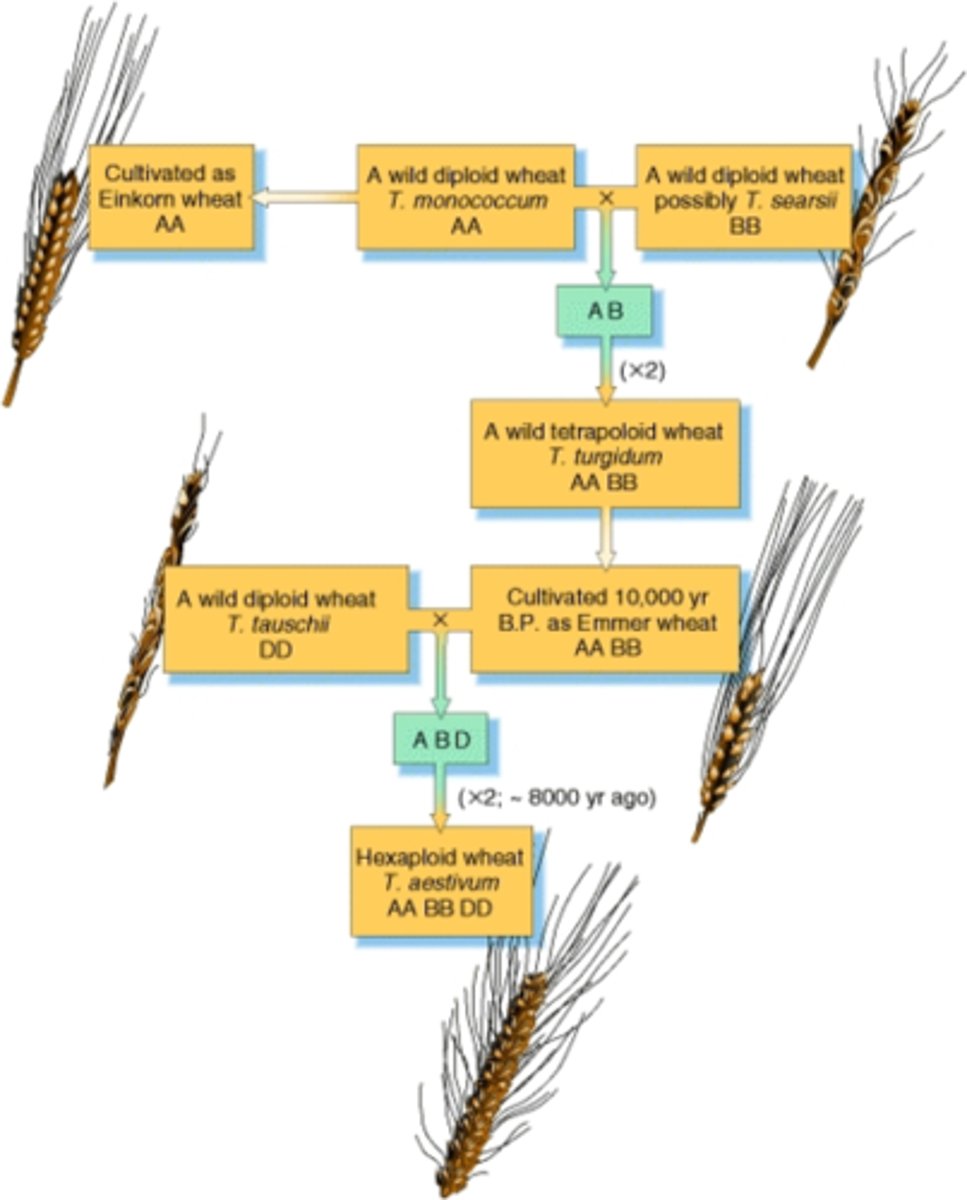Economic Botany - Exam 1 - Polyploidy and Interspecific Hybridization 6 and Polyploidy Overview 7
1/49
There's no tags or description
Looks like no tags are added yet.
Name | Mastery | Learn | Test | Matching | Spaced |
|---|
No study sessions yet.
50 Terms
What is interspecific hybridization?
Crossing between two or more different species.
What is polyploidy?
Whole genome duplication. It results in offspring that have a different chromosome number from their parents.
What is the expanded taxonomy used for crop plants? Why?
Because there is so much diversity in crop plants and their wild relatives, botanists often use a few additional levels of classification:
Kingdom
Phylum
Class
Family
Genus
* Section
Species
* Subspecies
Define the plant genome.
The genetic material housed within the nucleus, chloroplast, or mitochondrion of a plant or other organism.
Define heredity.
Biological inheritance
Define genetics.
Scientific study of inheritance
Define genomics.
The field of genetics that studies the content, organization, and function of the genetic information in whole genomes.
Define evolution.
Change in allele frequencies in populations over time.
Define gene.
Unit of heredity; sequence of DNA that codes for something or regulates transcription.
Define locus.
The position of a gene along a chromosome.
Define allele.
An alternative form of the same gene.
Define haplotype.
The collective genotype of a number of closely linked loci.
Plants have 3 genomes, what are they?
The nuclear genome, the chloroplast, and the mitochondrion.
How did the mitochondrion and the chloroplast originate?
Endosymbiotic theory: the mitochondrion and chloroplasts are derived from prokaryotic microbes that were engulfed into eukaryotic cells at some point in the evolutionary history of the organisms.
The data that support this are extensive, the strongest of which are derived from comparative genomic analysis of the mitochondrial genome and the chloroplast genome with both the nuclear DNA of the eukaryotic cell in which the mitochondrion and chloroplast reside as well as other bacterial genomes.
How is plant nuclear DNA organized?
Into linear chromosomes.
What is the size range of plant nuclear genomes?
They range 2350-fold, with the smallest plant genome = 63Mb and the largest plant genome = 149,000Mb.
1Mb = 1,000,000 base pairs
How does the number of chromosomes in the plant nuclear genome range?
It can range from 2 to 600 chromosomes.
What regions are found in nuclear plant DNA?
genes, coding regions, regulatory regions, and non-coding regions
How does epigenetics affect nuclear plant DNA?
Epigenetic modifications, non-genetic variation in the DNA molecule, can impact patterns of gene expression.
What percent of plant species have evidence of polyploidy in their genomes?
It is estimated that 100% of all plant species have some evidence of polyploidy in their genomes.
When did polyploidization events occur in evolutionary history?
Evidence suggests polyploidy has taken place throughout the evolutionary history of plants, with some polyploidization events more ancient and others more recent.
What 2 things can happen as a result of genome doubling (polyploidy)?
Gene loss: about half of all duplicated genes are lost. It appears that multiple copies of genes are preferentially retained following polyploidy whereas others are preferentially lost. Gene loss is not a random process.
Functional diversification: gene copies evolve to exhibit different expression patterns.
- Neofunctionalization: duplicated genes acquire a new function
- Subfunctionalization: the gene pair partitions the ancestral function (splits the work)
In what 2 ways can polyploidy happen?
Allopolyploidy or Autopolyploidy

What occurs in allopolyploidy?
Polyploidy is derived from hybridization of individuals with different chromosome numbers.

What occurs in autopolyploidy?
Polyploidy derived from doubling of its own chromosomes or by crossing with a member of the same species.

Is polyploidy rare?
No
What is inter-specific hybridization? Does it always lead to allopolyploidy?
Inter-specific hybridization is crossing between two different species to yield hybrid offspring.
Hybridization can result in allopolyploidy, but does not always result in allopolyploidy.
How does the biological species concept complicate polyploidy?
The biological species concept is defined as "members of populations that actually or potentially interbreed in nature". However, in plants many closely related species are completely interfertile (can interbreed and produce fertile offspring). Although they are interfertile, they are considered separate species because they are morphologically and genetically distinct from one another.
How can hybridization result in a hybrid swarm?
Hybridization is often followed by introgression - repeated, ongoing gene flow between 2 species. Usually, the hybrid offspring backcross with one or more of the parental species. If this exchange between species, and then from hybrid offspring back into one or two of the species continues, a hybrid swarm can form - a cluster or population of individuals that are products of hybridization and backcrossing.
Describe the polyploidization of cotton (Gossypium).
Cotton is part of the genus Gossypium, which includes more than 50 wild species. There are 4 different species of domesticated cotton (evolved under artificial selection by humans). These are:
- G. hirsutum (Upland cotton)
- G. barbadense (Pima cotton)
- G. herbaceum (Levant cotton)
- G. arboretum (tree cotton!!)
G. herbaceum and G. arboretum have 13 pairs of chromosomes. However, G. hirsutum and G. barbadense both have 26 pairs of chromosomes - they are POLYPLOID.
Genetic data suggests the polyploid domesticated cotton species are derived from an unlikely hybridization event that occured between an Old World African diploid Gosspium species containing the A genome and a New World species containing the D genome. A trans-oceanic dispersal event occurred, and the individuals carrying the A and D genome hybridized, undergoing allopolyploidy. It gave rise to six tetraploid species, two of which were domesticated.

Describe the polyploidization of wheat (Triticum).
Wheat belongs to the genus Triticum in the grass family (Poaceae).
The wild relatives of wheat are native to the fertile crescent in the Middle East. Early farmers began cultivating a wild, diploid species carrying the AA genome, wild Einkorn wheat (Triticum monococcum). Another diploid wild wheat species carrying the AA genome (Triticum urartu) hybridized with another wild wheat species, which carried the BB genome. This hybridization event led to the allopolyploid origin of wild emmer wheat (Triticum turgidum ssp. dicoccoides).
Early farmers began cultivating Triticum turgidum ssp. dicoccoides ~10,000 years ago. It is a free-threshing wheat. Domesticated emmer wheat was futher selected upon, ultimately leading to the evolution of cultivated tetraploid durum or macaroni wheat (T. turgidum ssp. durum).
Emmer wheat then hybridized with another wild diploid wheat species Triticum tauschii (DD genome). This led to a hexaploid wheat species Triticum aestivum (AABBDD), also known as bread wheat.

Define domestication.
The evolution of plants in response to artificial selection
Define domesticated organisms (crops)
Have evolved under artificial selection. Domesticated organisms have changed, often both in terms of their form (morphology) and their genetics, in response to selection by humans.
Define artificial selection.
Selection where humans, not nature, are the main drivers/agents of selection.
Who are the progenitors of all domesticated plants?
Wild undomesticated plant species that are found in nature.
How do we know if something is domesticated?
We know this by comparing crops or other cultivated organisms with their wild ancestors. The signatures of domestication are usually pretty major morphological and genetic differences among the crop/domesticated organisms and its wild ancestor.
What is the domestication syndrome?
The suite of traits that evolve in cultivated plants undergoing domestication.
What is crop improvement?
Artificial selection on crops that are already domesticated.
How do the genomes differ in allopolyploidy vs autopolyploidy?
Allopolyploidy - typically have two or more subgenomes, one from each parent. The genomes differ from one another because they are derived from different parents.
Autopolyploidy - Often have 3 or more copies of the same genome.
Crop species are widely viewed as good model systems. What does this mean?
- Model systems are species that serve as models illustrating broader principles in life and in other groups of organisms.
- Crops are seen as models for investigating polyploidy because we know a lot about the genomes of crop plants, and often about their evolutionary history.
- Studies of crop species provide insights into more general principles of how polyploidy works in plants. In addition, these studies can help us understand how genome duplication and diversification facilitates evolution under strong directional selection, as is the case during domestication.
Genomic shock often follows a polyploidy event. What is genomic shock?
Can include fractionation, translocation, aneuploidy (chromosome gains and losses), and genomic plasticity (changes in the extent of gene expression, changes in copy number of a particular gene, and gene conversion where one homolog over-writes the other homolog).
It introduces new variation into a population.
Following a polyploidy event, genome diploidization and gene fractionation can occur. What is this?
Genome Diploidization: Whole genome duplication is often followed by a process called diploidization - the duplicated genome gets pared down following duplication. Individuals that have undergone the whole genome duplication often evolve to function like a diploid.
Genome Fractionization/Downsizing: Following duplication, this can involve the loss of repetitive DNA through recombination or small deletions. Often duplicate genes are lost, often in a biased manner where genes from one genome are lost at a greater rate than genes from the other genome.
What is gene loss?
About half of all duplicated genes are lost. It appears that multiple copies of genes are preferentially retained following polyploidy (such as those involved in transcription and signal transduction) and others are preferentially lost (such as those involved in DNA repair and organellar proteins).
It is NOT a random process.
What is gene retention?
In some regions of the genome, both copies of DNA are retained. It is often the result of neo-functionalization: when one of the copies of the genes evolves a new function.
What allows us to investigate broad patterns of expression across multiple genes that are likely interacting with each other?
Gene co-expression networks.
What are examples of epigenetic modifications?
Methylation at cytosine sites, histone modifications, etc.
Describe heterosis, also known as hybrid vigor.
The phenomenon where the hybrid offspring is more vigorous than either of its parents. More vigorous can mean greater biomass, fertility, growth rate, or other traits.
EX: In cotton, allopolyploid species have longer fibers than either of the parents. There is evidence that suggests there is upregulation in polyploid individuals of genes involved in cell-wall biogenesis.
Define cytological examination
examination of chromosome numbers
Define paleopolyploidy
ancient polyploidy
Define RNA-seq
A method of sequencing RNA which provides information on the cDNA sequence underlying RNA as well as the amount of transcription that is happening.